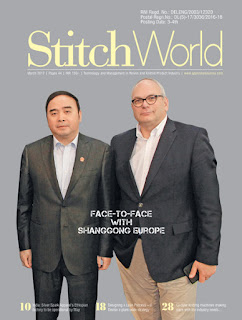'The industry is on a ventilator' – that's the general sentiment in the industry
today… Many factors have influenced the way the industry is today, which
started with demonetization that reduced the money in hand, then GST
which led to money being blocked and thereafter came the final hammer, the
withdrawal of duty drawback...
Not to forget the ongoing struggle of continuous squeeze on prices by the buyers, higher inflation and dwindling order quantities.
‘What to do?’ is a common question which is the starting point of any discussion that one has today, irrespective of whether one is attending a marriage or any other function (this being the auspicious time of the year when social gatherings are aplenty!). The discussion invariably drifts towards the topic of ‘survival’.
Only recently I was with a Bangladeshi delegation of 22 sweater exporters in Japan, Osaka and they also have the same issue of sustenance. Since the country is majorly doing basic products in volume, the problem of plummeting prices is impacting them even more.
I was cornered to tell them what's happening in India, and to know how the companies there are addressing the 'survival' issue. Though I shared my understanding about India to them, what I observed is that they all have a plan in place to counter the problem…that is to increase the capacity using automation and to build operational efficiencies.
I would say that this is the best strategy to mitigate slowdown by becoming the indispensable and thus the preferred suppliers. I believe that collectively the industry has enough depth, but unlike China, they need to learn to say NO.
In these difficult times, when saving every cent counts, automation is supporting the industry in its goal to save on cost. This issue carries an exploration of the journey of automation and discusses how it has become ‘important’ and ‘affordable’, from being considered ‘unviable’ and ‘expensive’.
Moving beyond the traditional mindset, the Indian Government has recently taken away the responsibility of the procurement of 48 items for the Indian Army from the Ordnance Factory Board (OFB) and given it to the private sector. Seen as a major opportunity for the sewn industry, inside is the complete picture of the expectations of the Indian Army from the local Indian manufacturers.
Celebrating success is important and IMA s.p.a., a pioneer in cutting solutions, recently completed its 40 years’ of establishment with a stupendous event in Bergamo, Italy. This issue carries a snapshot of the event and the launch of ‘TYPHOON 70’ cutter during the occasion.
Not to forget the ongoing struggle of continuous squeeze on prices by the buyers, higher inflation and dwindling order quantities.
‘What to do?’ is a common question which is the starting point of any discussion that one has today, irrespective of whether one is attending a marriage or any other function (this being the auspicious time of the year when social gatherings are aplenty!). The discussion invariably drifts towards the topic of ‘survival’.
Only recently I was with a Bangladeshi delegation of 22 sweater exporters in Japan, Osaka and they also have the same issue of sustenance. Since the country is majorly doing basic products in volume, the problem of plummeting prices is impacting them even more.
I was cornered to tell them what's happening in India, and to know how the companies there are addressing the 'survival' issue. Though I shared my understanding about India to them, what I observed is that they all have a plan in place to counter the problem…that is to increase the capacity using automation and to build operational efficiencies.
I would say that this is the best strategy to mitigate slowdown by becoming the indispensable and thus the preferred suppliers. I believe that collectively the industry has enough depth, but unlike China, they need to learn to say NO.
In these difficult times, when saving every cent counts, automation is supporting the industry in its goal to save on cost. This issue carries an exploration of the journey of automation and discusses how it has become ‘important’ and ‘affordable’, from being considered ‘unviable’ and ‘expensive’.
Moving beyond the traditional mindset, the Indian Government has recently taken away the responsibility of the procurement of 48 items for the Indian Army from the Ordnance Factory Board (OFB) and given it to the private sector. Seen as a major opportunity for the sewn industry, inside is the complete picture of the expectations of the Indian Army from the local Indian manufacturers.
Celebrating success is important and IMA s.p.a., a pioneer in cutting solutions, recently completed its 40 years’ of establishment with a stupendous event in Bergamo, Italy. This issue carries a snapshot of the event and the launch of ‘TYPHOON 70’ cutter during the occasion.









